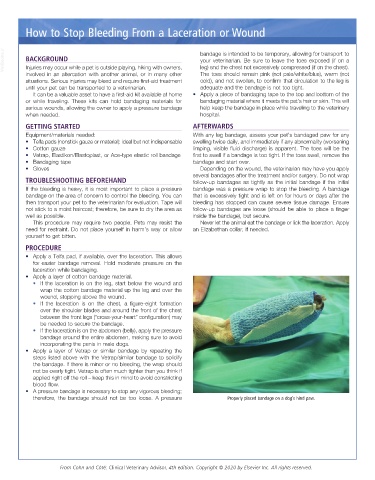Page 3251 - Cote clinical veterinary advisor dogs and cats 4th
P. 3251
How to Stop Bleeding From a Laceration or Wound
VetBooks.ir BACKGROUND bandage is intended to be temporary, allowing for transport to
your veterinarian. Be sure to leave the toes exposed (if on a
leg) and the chest not excessively compressed (if on the chest).
Injuries may occur while a pet is outside playing, hiking with owners,
involved in an altercation with another animal, or in many other The toes should remain pink (not pale/white/blue), warm (not
situations. Serious injuries may bleed and require first-aid treatment cold), and not swollen, to confirm that circulation to the leg is
until your pet can be transported to a veterinarian. adequate and the bandage is not too tight.
It can be a valuable asset to have a first-aid kit available at home • Apply a piece of bandaging tape to the top and bottom of the
or while traveling. These kits can hold bandaging materials for bandaging material where it meets the pet’s hair or skin. This will
serious wounds, allowing the owner to apply a pressure bandage help keep the bandage in place while traveling to the veterinary
when needed. hospital.
GETTING STARTED AFTERWARDS
Equipment/materials needed: With any leg bandage, assess your pet’s bandaged paw for any
• Telfa pads (nonstick gauze or material): ideal but not indispensable swelling twice daily, and immediately if any abnormality (worsening
• Cotton gauze limping, visible fluid discharge) is apparent. The toes will be the
• Vetrap, Elastikon/Elastoplast, or Ace-type elastic roll bandage first to swell if a bandage is too tight. If the toes swell, remove the
• Bandaging tape bandage and start over.
• Gloves Depending on the wound, the veterinarian may have you apply
several bandages after the treatment and/or surgery. Do not wrap
TROUBLESHOOTING BEFOREHAND follow-up bandages as tightly as the initial bandage if the initial
If the bleeding is heavy, it is most important to place a pressure bandage was a pressure wrap to stop the bleeding. A bandage
bandage on the area of concern to control the bleeding. You can that is excessively tight and is left on for hours or days after the
then transport your pet to the veterinarian for evaluation. Tape will bleeding has stopped can cause severe tissue damage. Ensure
not stick to a moist haircoat; therefore, be sure to dry the area as follow-up bandages are loose (should be able to place a finger
well as possible. inside the bandage), but secure.
This procedure may require two people. Pets may resist the Never let the animal eat the bandage or lick the laceration. Apply
need for restraint. Do not place yourself in harm’s way or allow an Elizabethan collar, if needed.
yourself to get bitten.
PROCEDURE
• Apply a Telfa pad, if available, over the laceration. This allows
for easier bandage removal. Hold moderate pressure on the
laceration while bandaging.
• Apply a layer of cotton bandage material.
• If the laceration is on the leg, start below the wound and
wrap the cotton bandage material up the leg and over the
wound, stopping above the wound.
• If the laceration is on the chest, a figure-eight formation
over the shoulder blades and around the front of the chest
between the front legs (“cross-your-heart” configuration) may
be needed to secure the bandage.
• If the laceration is on the abdomen (belly), apply the pressure
bandage around the entire abdomen, making sure to avoid
incorporating the penis in male dogs.
• Apply a layer of Vetrap or similar bandage by repeating the
steps listed above with the Vetrap/similar bandage to solidify
the bandage. If there is minor or no bleeding, the wrap should
not be overly tight. Vetrap is often much tighter than you think if
applied right off the roll – keep this in mind to avoid constricting
blood flow.
• A pressure bandage is necessary to stop any vigorous bleeding;
therefore, the bandage should not be too loose. A pressure Properly placed bandage on a dog’s hind paw.
From Cohn and Côté: Clinical Veterinary Advisor, 4th edition. Copyright © 2020 by Elsevier Inc. All rights reserved.

